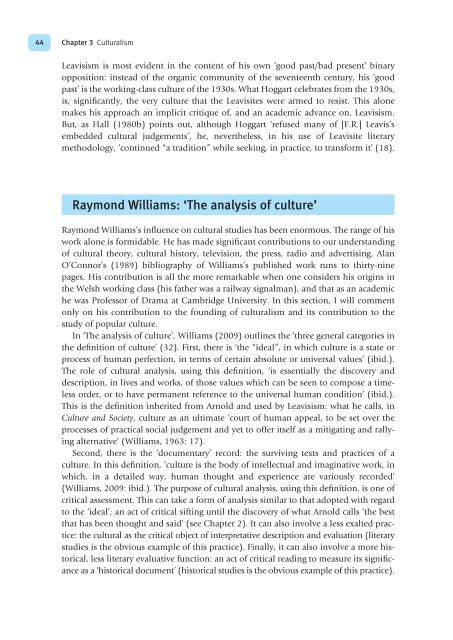Cultural Theory and Popular Culture
Cultural Theory and Popular Culture
Cultural Theory and Popular Culture
You also want an ePaper? Increase the reach of your titles
YUMPU automatically turns print PDFs into web optimized ePapers that Google loves.
44<br />
Chapter 3 <strong>Cultural</strong>ism<br />
Leavisism is most evident in the content of his own ‘good past/bad present’ binary<br />
opposition: instead of the organic community of the seventeenth century, his ‘good<br />
past’ is the working-class culture of the 1930s. What Hoggart celebrates from the 1930s,<br />
is, significantly, the very culture that the Leavisites were armed to resist. This alone<br />
makes his approach an implicit critique of, <strong>and</strong> an academic advance on, Leavisism.<br />
But, as Hall (1980b) points out, although Hoggart ‘refused many of [F.R.] Leavis’s<br />
embedded cultural judgements’, he, nevertheless, in his use of Leavisite literary<br />
methodology, ‘continued “a tradition” while seeking, in practice, to transform it’ (18).<br />
Raymond Williams: ‘The analysis of culture’<br />
Raymond Williams’s influence on cultural studies has been enormous. The range of his<br />
work alone is formidable. He has made significant contributions to our underst<strong>and</strong>ing<br />
of cultural theory, cultural history, television, the press, radio <strong>and</strong> advertising. Alan<br />
O’Connor’s (1989) bibliography of Williams’s published work runs to thirty-nine<br />
pages. His contribution is all the more remarkable when one considers his origins in<br />
the Welsh working class (his father was a railway signalman), <strong>and</strong> that as an academic<br />
he was Professor of Drama at Cambridge University. In this section, I will comment<br />
only on his contribution to the founding of culturalism <strong>and</strong> its contribution to the<br />
study of popular culture.<br />
In ‘The analysis of culture’, Williams (2009) outlines the ‘three general categories in<br />
the definition of culture’ (32). First, there is ‘the “ideal”, in which culture is a state or<br />
process of human perfection, in terms of certain absolute or universal values’ (ibid.).<br />
The role of cultural analysis, using this definition, ‘is essentially the discovery <strong>and</strong><br />
description, in lives <strong>and</strong> works, of those values which can be seen to compose a timeless<br />
order, or to have permanent reference to the universal human condition’ (ibid.).<br />
This is the definition inherited from Arnold <strong>and</strong> used by Leavisism: what he calls, in<br />
<strong>Culture</strong> <strong>and</strong> Society, culture as an ultimate ‘court of human appeal, to be set over the<br />
processes of practical social judgement <strong>and</strong> yet to offer itself as a mitigating <strong>and</strong> rallying<br />
alternative’ (Williams, 1963: 17).<br />
Second, there is the ‘documentary’ record: the surviving texts <strong>and</strong> practices of a<br />
culture. In this definition, ‘culture is the body of intellectual <strong>and</strong> imaginative work, in<br />
which, in a detailed way, human thought <strong>and</strong> experience are variously recorded’<br />
(Williams, 2009: ibid.). The purpose of cultural analysis, using this definition, is one of<br />
critical assessment. This can take a form of analysis similar to that adopted with regard<br />
to the ‘ideal’; an act of critical sifting until the discovery of what Arnold calls ‘the best<br />
that has been thought <strong>and</strong> said’ (see Chapter 2). It can also involve a less exalted practice:<br />
the cultural as the critical object of interpretative description <strong>and</strong> evaluation (literary<br />
studies is the obvious example of this practice). Finally, it can also involve a more historical,<br />
less literary evaluative function: an act of critical reading to measure its significance<br />
as a ‘historical document’ (historical studies is the obvious example of this practice).
















